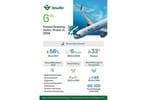The International Air Transport Association (IATA) announced global passenger traffic results for April 2019 showing that demand (revenue passenger kilometers or RPKs) rose by 4.3% compared to April 2018. April capacity (available seat kilometers or ASKs) increased by 3.6%, and load factor climbed 0.6 percentage point to 82.8%, which was a record for the month of April, surpassing last year’s record of 82.2%. Regionally, Africa, Europe and Latin America posted record load factors.
Comparisons between the two months are distorted owing to the timing of the Easter holiday, which occurred on 1 April in 2018 but fell much later in the month in 2019.
“We experienced solid but not exceptional rising demand for air connectivity in April. This partly is owing to the timing of Easter, but also reflects the slowing global economy. Driven by tariffs and trade disputes, global trade is falling, and as a result, we are not seeing traffic growing at the same levels as a year ago. However, airlines are doing a very good job of managing aircraft utilization, leading to record load factors.” said Alexandre de Juniac, IATA’s Director General and CEO.
aprilie 2019
(% an dupa an) |
Cota mondială1 |
RPK |
CERE |
PLF (% -pt)2 |
PLF (nivel)3 |
| Piața totală |
100.0% |
4.3% |
3.6% |
0.6% |
82.8% |
| Africa |
2.1% |
1.6% |
0.6% |
0.7% |
73.3% |
| Asia-Pacific |
34.4% |
2.1% |
3.2% |
-0.9% |
81.7% |
| Europa |
26.7% |
7.6% |
6.3% |
1.0% |
85.1% |
| America Latină |
5.1% |
5.7% |
4.7% |
0.8% |
82.2% |
| Orientul Mijlociu |
9.2% |
2.6% |
-1.6% |
3.3% |
80.3% |
| America de Nord |
22.5% |
4.4% |
3.4% |
0.8% |
83.9% |
|
| 1% din RPK-urile din industrie în 2018 2Schimbare de la an la an a factorului de încărcare 3Nivelul factorului de încărcare |
 Piețe internaționale de pasageri Piețe internaționale de pasageri
April international passenger demand rose 5.1% compared to April 2018. All regions recorded year-over-year traffic increases, led by airlines in Europe. Total capacity climbed 3.8%, and load factor climbed 1.1 percentage points to 82.5%.
- Companiile aeriene europene’ April traffic increased 8.0% compared to the year-ago period, up from 4.9% annual growth in March. While this represented the strongest monthly growth since December, on a seasonally-adjusted basis, RPKs have only risen by 1% since November 2018, suggesting the global economic and trade backdrop – along with the uncertainty surrounding Brexit – is impacting demand. Capacity rose 6.6% and load factor surged 1.1 percentage points to 85.7%, highest among the regions.
- Transportatori Asia-Pacific posted a 2.9% traffic rise in April, up from 2% growth in March but well below the long-term average. Capacity climbed 3.7% and load factor dropped 0.6 percentage point to 80.8%. Asia-Pacific was the only region to experience a decline in load factor compared to the same month a year ago. Results largely reflect the slowdown in global trade, including the impact from the China-US trade tensions on the broader region, which continue to weigh on passenger demand.
- Transportatori din Orientul Mijlociu saw demand rise 2.9% in April, which was a recovery from a 3.0% decline in traffic in March. Notwithstanding the monthly turnaround, in seasonally-adjusted terms the downward trend in traffic growth continues, reflecting broader structural changes affecting the industry in the region. Capacity fell 1.6% and load factor soared 3.5 percentage points to 80.5%.
- Companiile aeriene din America de Nord posted a 5.5% demand increase compared to April 2018, which was up from 3.2% year-over-year growth in March. A strong domestic economy, low unemployment and a strong dollar are offsetting any impacts from current trade tensions. Capacity climbed 3.2%, and load factor rose 1.8 percentage points to 82.2%.
- Companiile aeriene latino-americane experienced a 5.2% rise in April demand compared to the same month last year, slightly up on 4.9% growth in March. Capacity increased by 4.0% and load factor edged up 0.9 percentage point to 82.8%. The strong results are occurring against a backdrop of economic and political uncertainty in some key regional economies. Strong South-North traffic flows may be supporting demand growth.
- Companiile aeriene africane had a 1.1% traffic increase in April, which was down from 1.6% growth in March and was the slowest regional growth since early 2015. Like Latin America, Africa is seeing some economic and political uncertainty in the largest markets. Capacity climbed 0.1%, and load factor edged up 0.7 percentage point to 72.6%.
|
Piețe interne de pasageri
Demand for domestic travel climbed 2.8% in April compared to April 2018, down from 4.1% growth in March year-over-year. The slowing trend is being driven primarily by developments in China and India discussed below. Capacity increased 3.2%, and load factor slid 0.3 percentage point to 83.2%. |
aprilie 2019
(% an dupa an) |
Cota mondială1 |
RPK |
CERE |
PLF (% -pt)2 |
PLF (nivel)3 |
| Intern |
36.0% |
2.8% |
3.2% |
-0.3% |
83.2% |
| Australia |
0.9% |
-0.7% |
0.4% |
-0.9% |
79.5% |
| Brazilia |
1.1% |
0.6% |
-1.1% |
1.4% |
81.9% |
| China PR |
9.5% |
3.4% |
5.4% |
-1.6% |
84.3% |
| India |
1.6% |
-0.5% |
0.5% |
-0.9% |
88.6% |
| Japonia |
1.0% |
3.4% |
2.6% |
0.5% |
67.3% |
| Fed rusesc |
1.4% |
10.4% |
10.4% |
0.0% |
81.0% |
| US |
14.1% |
4.1% |
3.8% |
0.2% |
84.7% |
|
|
|
|
|
1% din RPK-urile din industrie în 2018 2Schimbare de la an la an a factorului de încărcare 3Nivelul factorului de încărcare
|
- China’s domestic traffic increased 3.4% in April, up from 2.8% in March, but still well below the 2016-2018 period when growth averaged around 12%, reflecting the impact of the US-China trade dispute and softening in a number of economic indicators.
- India’s airlines’ traffic actually fell 0.5% year-over-year, reflecting the impact of the shut-down of Jet Airways. This marked the first time in six years that monthly domestic traffic declined compared to the year-ago period.
|
- Asia-Pacific was the only region to experience a decline in load factor compared to the same month a year ago.
- Driven by tariffs and trade disputes, global trade is falling, and as a result, we are not seeing traffic growing at the same levels as a year ago.
- Comparisons between the two months are distorted owing to the timing of the Easter holiday, which occurred on 1 April in 2018 but fell much later in the month in 2019.



 Piețe internaționale de pasageri
Piețe internaționale de pasageri



















